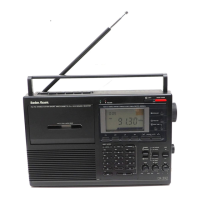22
LOCKING THE
CONTROLS
The lock feature prevents you from ac-
cidentally turning the receiver on or off,
changing the band or frequency, or se-
lecting front-panel buttons.
Set the lock switch to to lock all
the front-panel buttons and the
ROTA-
RY TUNING
dial. You can still adjust
VOLUME
,
TONE
, and other controls.
Set the switch to the other position to
unlock the buttons.
Note:
To lock only the
ROTARY TUN-
ING
dial, see “Using the Rotary Dial” on
Page 10.
LISTENING HINTS
Shortwave listening is a hobby with
thousands of participants worldwide. It
requires no special knowledge or
skills, but your enjoyment increases as
you gain experience and develop spe-
cial listening techniques.
The information in this section can help
you make the most of your DX-392.
REFERENCE SOURCES
Many books and magazines about
shortwave listening are available
through your local library or news-
stand. Consult sources such as the
World Radio Handbook
,
Radio Ama-
teur’s Handbook
,
Passport to World
Band Radio
,
Monitoring Times
, and
Popular Communications
. These pub-
lications can help you learn about the
conditions that make long-distance re-
ception possible and provide up-to-
date listings for shortwave broadcasts
in English and in other languages.
FREQUENCY
CONVERSION
A band is a group of frequencies.
Sometimes, bands are grouped ac-
cording to their wavelengths, in
meters. The tuning location of a station
can be expressed as a frequency (kHz
or MHz) or a wavelength (meters).
Amateur radio operators generally re-
fer to the frequencies they operate on
using the frequency’s wavelength. For
example, the 19-meter band refers to
the range of frequencies with waves
about 19 meters long.
Use the following equations to convert
kHz, MHz, and meters.
To convert MHz to kHz, multiply by
1,000. For example:
9.62 MHz ¥ 1000 = 9,620 kHz
20-219.fm Page 22 Wednesday, August 4, 1999 9:23 AM

